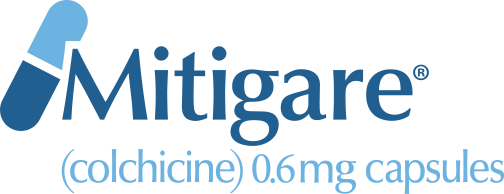
Gout affects more than 9 million Americans.1 In spite of how common it is, many people do not know the facts about gout.1,2 Instead, misinformation, misconceptions and even stigma abound.2 Whether you suspect you have gout, have already been diagnosed with the disease or love someone who is living with it, you probably have questions. Read on to learn more and get the facts about gout.
What is gout?
Gout is the most common form of arthritis.1 It is caused by a condition called hyperuricemia, which is the medical term for having excess uric acid in the bloodstream.1 Hyperuricemia can occur if the body makes too much uric acid or if the kidneys do not get rid of enough of it.1 Reducing the level of uric acid in the body to a healthy range—6.0 mg/dL or below—is key to successfully managing gout.1
What does gout feel like?
For most people who suffer with gout flares (also known as gout attacks), the symptoms typically include sudden redness, swelling and excruciating pain.3 In a survey of people with gout, nearly one in five participants said that nothing hurts more than a gout flare.4 (Thirty-nine percent of participants in the same study said the pain of gout was worse than that caused by a severe burn, 36% said it was worse than kidney stones, 34% said it was worse than breaking a bone, 29% said it was worse than childbirth and 25% said it was worse than being hit by a car.4)
What causes gout?
Uric acid may build up in the bloodstream for a while before a person notices any symptoms.5 As the uric acid level rises, sharp, needle-like urate crystals can slowly begin to form around a joint.3 For many people it’s the big toe, but a lesser known fact about gout is that it can also affect knees and wrists.3 Eventually, these crystals can cause the intense pain, redness and swelling associated with gout attacks.3 Gout attacks can be caused by a number of triggers—consuming certain foods and beverages, medications, surgery or sudden illness and stress, for example.1,3,6 The pain of a gout flare usually is the most severe in the first four to 12 hours after it begins and can linger for several days.3,7
Who gets gout?
Gout affects both genders, but is slightly more common in men.1 Men also typically develop gout at a younger age than women (women tend to develop gout after menopause).1 There appear to be some racial differences among people with gout as well.8,9 According to the results of two separate studies, Asian and Black Americans are more likely to develop gout than White Americans.8,9
Why do people get gout?
You’re more likely to develop gout if you have certain risk factors.1 Common risk factors for gout include:1
- Heredity—People who have family members with gout are more likely to develop the disease.
- Weight—People who are overweight are more likely to develop gout because their bodies tend to produce more uric acid than the bodies of people who are not overweight. (Their kidneys have a more difficult time eliminating uric acid as well.)
- Gender—Men are more likely to develop gout than women.
- Diet—Eating a high-purine diet (red meat, shellfish, processed foods and sweets, for example) and drinking alcohol and/or sugary beverages can raise the risk of gout.
- Certain medical conditions—Untreated high blood pressure and chronic conditions such as diabetes, metabolic syndrome and heart and kidney diseases can increase the risk of gout.
How is gout diagnosed?
If you suspect you have gout, make an appointment to see your doctor right away. Your doctor will probably examine your affected joint and recommend tests to confirm a diagnosis.10 These tests may include a joint fluid test (where a needle is used to take fluid from the joint so it can be examined under a microscope), a blood test to measure the level of uric acid in your blood, x-rays, ultrasound and/or dual-energy computerized tomography (also known as DECT, which combines x-ray images taken from various angles to visualize urate crystals in joints).10
How is gout managed?
Many people with gout take two kinds of medications: 1) a urate-lowering therapy (ULT) such as allopurinol to help reduce the amount of uric acid in the bloodstream and 2) an anti-inflammatory medication such as colchicine to prevent painful gout flares.11 Ironically, many people who take ULT experience gout flares when they first begin treatment.12 These flares can happen when the uric acid level in the bloodstream begins to come down and the urate crystals in the affected joint start to dissolve.12 That’s why the American College of Rheumatology/Gout Management Guidelines recommend anti-inflammatory therapy with a medication like colchicine for the first 3-6 months of ULT.13 Mitigare® (Colchicine) 0.6mg Capsules are one such colchicine product.14
Why do I need to manage my gout?
Gout is a serious condition.1 Until it is managed effectively, gout can continue to cause pain and may eventually destroy and disfigure joints.2,15 Gout can also lead to kidney stones and kidney disease.2 It can even affect a person’s quality of life—according to the results of a 2019 survey conducted by the Gout Education Society, four out of 10 people with gout feel their quality of life is not as good because of the disease.4
How should I manage my gout?
Although gout is considered a chronic disease, it can be managed (and in many cases, controlled) with appropriate treatment.1 The right combination of medication and lifestyle changes can help stop the buildup of uric acid in the body and prevent long-term complications.1 If you are not already seeing your doctor regularly, be sure to schedule checkups every six months and have your uric acid level checked at each visit.11 If your uric acid level is high, your doctor may recommend ULT (if you are not already taking it).11 Your doctor may also recommend colchicine therapy with Mitigare® (Colchicine) 0.6mg Capsules to help prevent gout flares.11,14
Mitigare® is a registered trademark of Hikma Pharmaceuticals USA Inc.
Colchicine 0.6 mg capsules are contraindicated in patients with renal or hepatic impairment who are currently prescribed drugs that inhibit both P-gp and CYP3A4. Combining these dual inhibitors with colchicine in patients with renal or hepatic impairment has resulted in life-threatening or fatal colchicine toxicity. Patients with both renal and hepatic impairment should not be given Mitigare®.
Fatal overdoses have been reported with colchicine in adults and children. Keep Mitigare® out of the reach of children.
Blood dyscrasias such as myelosuppression, leukopenia, granulocytopenia, thrombocytopenia and aplastic anemia have been reported with colchicine used in therapeutic doses.
Monitor for toxicity and, if present, consider temporary interruption or discontinuation of colchicine.
Drug interaction with dual P-gp and CYP3A4 inhibitors: Co-administration of colchicine with dual P-gp and CYP3A4 inhibitors has resulted in life-threatening interactions and death.
Neuromuscular toxicity and rhabdomyolysis may occur with chronic treatment with colchicine in therapeutic doses, especially in combination with other drugs known to cause this effect. Patients with impaired renal function and elderly patients (including those with normal renal and hepatic function) are at increased risk. Consider temporary interruption or discontinuation of Mitigare®.
The most commonly reported adverse reactions with colchicine are gastrointestinal symptoms, including diarrhea, nausea, vomiting and abdominal pain.
Please see the full Prescribing Information and Medication Guide for Mitigare® for complete product details.
NOTE: This article was not written by a medical professional and is not intended to substitute for the guidance of a physician. These are not Hikma’s recommendations for gout flare prevention, but rather facts and data collected from various reliable medical sources. For a full list of resources and their attributing links, see below.
